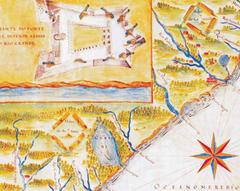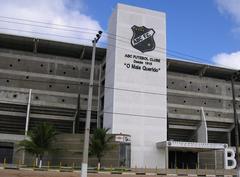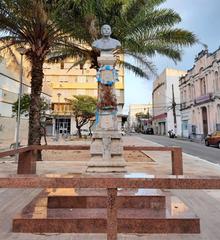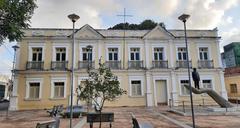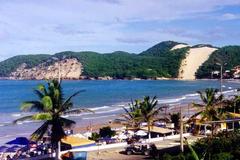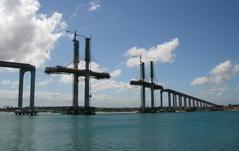Visiting Pedra do Rosário in Natal: Hours, Tickets, and Tips
Date: 24/07/2024
Introduction
Pedra do Rosário in Natal, Brazil, is a captivating historical and cultural landmark that beckons travelers with its rich heritage and scenic beauty. Nestled in the Cidade Alta neighborhood on the right bank of the Potenji River, this site is not just a geographical marker but a symbol of Natal’s storied past. The city’s history stretches back to 1597 when Portuguese explorers first arrived, establishing Natal as a defensive outpost against French incursions (Brazil Travel Buddy). Over the centuries, Natal has played pivotal roles during the colonial era and World War II, making it a site of profound historical significance.
Pedra do Rosário is intrinsically linked to the Church of Our Lady of the Rosary of Black People, a modest yet significant temple that stands as a testament to the city’s cultural and social fabric. This church has withstood the test of time, witnessing numerous transformations in Natal’s urban landscape (Academia.edu). The site serves as a vital social space, preserving regional history and memory despite facing challenges of urban invisibility and social oblivion.
Table of Contents
- Pedra do Rosário in Natal, Brazil - History, Visiting Hours, and Ticket Information
- Introduction
- Early History and Foundation
- Colonial Era and Dutch Invasion
- Pedra do Rosário and Its Cultural Significance
- Social and Artistic Heritage
- World War II and Modern Era
- Visitor Information
- Nearby Attractions
- Preservation Efforts and Challenges
- Cultural Celebrations and Community Involvement
- FAQ
- Conclusion
Pedra do Rosário in Natal, Brazil - History, Visiting Hours, and Ticket Information
Introduction
Discover the rich history, cultural significance, and visitor information of Pedra do Rosário in Natal, Brazil. From its colonial roots to its role during World War II, learn about this historical gem and plan your visit with essential tips and insights.
Early History and Foundation
Pedra do Rosário, located in Natal, Brazil, is a site of significant historical importance. The history of Natal dates back nearly 400 years when the first Portuguese explorers arrived at the Potenji River in 1597. They established a new city and fortress to fend off French incursions. The village, founded in 1598, was named Natal, meaning Christmas, reflecting the date of its establishment (Brazil Travel Buddy).
Colonial Era and Dutch Invasion
The strategic importance of Natal was underscored during the colonial era. Between 1633 and 1654, the Dutch managed to seize control of the fortress from the Portuguese. This period saw significant conflict and eventual reclamation by the Portuguese. The city played a crucial role in the export of sugar cane and gold, which were vital to the colonial economy (World Guides).
Pedra do Rosário and Its Cultural Significance
Pedra do Rosário is not just a geographical landmark but also a cultural and historical symbol. The site is closely associated with the Church of Our Lady of the Rosary of Black People, a humble temple in the Cidade Alta neighborhood. This church has witnessed numerous historical moments and changes in the urban landscape of Natal. According to Luis da Câmara Cascudo, a renowned historian, the church is one of the most modest yet significant temples in the city (Academia.edu).
Social and Artistic Heritage
The Church of Our Lady of the Rosary of Black People is a vital social space for local memory and regional history. Despite its historical significance, the church has faced urban invisibility and social oblivion, posing a threat to its artistic heritage. Efforts have been made to clarify the importance of this site and contribute to the preservation of local history (Academia.edu).
World War II and Modern Era
More recently, Natal played a crucial role during World War II as a supply station. Its proximity to Africa and Europe made it a strategic military position. Thousands of American soldiers were stationed in Natal, making it an often-overlooked partner during the war. This period added another layer to the rich history of Natal, with many buildings and cultural elements dating back to this era being preserved and restored throughout the city (Brazil Travel Buddy).
Visitor Information
Visiting Hours and Tickets
Pedra do Rosário and the Church of Our Lady of the Rosary of Black People are typically open to visitors from 9 AM to 5 PM daily. Admission is free, but donations are welcomed to support preservation efforts.
Travel Tips
- Best Time to Visit: The ideal time to visit is during the dry season from September to February.
- Guided Tours: Consider booking a guided tour to gain deeper insights into the history and significance of Pedra do Rosário.
- Photographic Spots: The area around the church offers excellent opportunities for photography, especially during sunset.
Nearby Attractions
- Fortaleza dos Reis Magos: Another historical site located nearby, offering insights into the colonial history of Natal.
- Ponte Newton Navarro: A modern architectural marvel that offers stunning views of the city and coastline.
- Praia do Meio: A beautiful beach perfect for relaxing after exploring historical sites.
Preservation Efforts and Challenges
The preservation of Pedra do Rosário and its associated historical sites has been a challenge. Ignorance and lack of involvement from the local community have contributed to the degradation of these sites. However, there have been concerted efforts to raise awareness about the importance of these cultural landmarks. Research and oral quizzes conducted among nearby residents have been instrumental in understanding the local perception and significance of these sites (Academia.edu).
Cultural Celebrations and Community Involvement
The Festa de Nossa Senhora do Rosário dos Homens Pretos de Chapada do Norte is a cultural celebration that highlights the importance of the Church of Our Lady of the Rosary of Black People. This celebration, recognized as an intangible cultural heritage of Minas Gerais since 2013, commemorates the dedication and resistance of the local community in honoring the Virgin of the Rosary. The festival encompasses various dimensions, including rituals, performances, social interactions, music, and material culture, reflecting the rich cultural tapestry of the region (Academia.edu).
FAQ
Q: What are the visiting hours for Pedra do Rosário?
A: The site is open daily from 9 AM to 5 PM.
Q: Is there an entrance fee?
A: Admission is free, but donations are appreciated.
Q: Are guided tours available?
A: Yes, guided tours can be booked to enhance your visit.
Q: What are the best times to visit?
A: The best time to visit is during the dry season from September to February.
Conclusion
Pedra do Rosário and its surrounding historical sites offer a deep dive into the rich and multifaceted history of Natal, Brazil. From its early colonial days to its strategic importance during World War II, and its ongoing cultural significance, this site remains a testament to the enduring legacy of the region. Preservation efforts and community involvement are crucial in maintaining the historical and cultural integrity of Pedra do Rosário, ensuring that future generations can continue to appreciate its significance.
Exploring Pedra do Rosário, Natal
Location and Accessibility
Geographic Location
Pedra do Rosário is situated in the vibrant city of Natal, the capital of the state of Rio Grande do Norte in Brazil. Specifically, it is located on the right bank of the Potenji River, a significant waterway that flows through the city. The exact coordinates place it within the Cidade Alta neighborhood, one of the oldest and most historically rich areas of Natal. The site is easily accessible via Avenida do Contorno, a major thoroughfare that connects various parts of the city.
Proximity to Key Landmarks
Pedra do Rosário is conveniently located near several key landmarks, making it an ideal stop for tourists exploring Natal. It is just a short distance from the historic center of Cidade Alta, where visitors can explore other significant sites such as the Natal Metropolitan Cathedral and the Alberto Maranhão Theatre. These landmarks, part of the rich tapestry of Natal historical sites, offer a comprehensive cultural and historical tour of the area.
Accessibility by Public Transport
Natal boasts a well-developed public transportation system, making Pedra do Rosário easily accessible for both locals and tourists. Several bus lines service the Cidade Alta neighborhood, with stops along Avenida do Contorno. Buses are a cost-effective and efficient way to reach the site, with frequent services running throughout the day. For those unfamiliar with the local bus routes, the Natal Bus System website provides detailed information on schedules and routes.
Accessibility by Private Transport
For those preferring private transport, Pedra do Rosário is easily reachable by car or taxi. The site offers limited parking facilities, but there are several parking lots in the vicinity, particularly around the historic center of Cidade Alta. Ride-sharing services like Uber and 99 are also widely available in Natal, providing a convenient and relatively inexpensive option for reaching the site.
Walking and Cycling
Given its central location, Pedra do Rosário is also accessible by foot or bicycle for those staying in nearby accommodations. The area around Cidade Alta is pedestrian-friendly, with well-maintained sidewalks and designated cycling paths. Walking or cycling to the site not only offers a more immersive experience but also allows visitors to explore the charming streets and historic architecture of the neighborhood.
Accessibility for People with Disabilities
Pedra do Rosário is committed to being accessible to all visitors, including those with disabilities. The site features ramps and pathways designed to accommodate wheelchairs and other mobility aids. Additionally, the local government has made efforts to improve the overall accessibility of public spaces in Natal, ensuring that visitors with disabilities can enjoy a comfortable and inclusive experience. For more detailed information on accessibility features, visitors can refer to the Natal Accessibility Guide.
Visitor Information
Best Times to Visit
Pedra do Rosário is open to visitors year-round, but certain times of the day and year offer a more memorable experience. The site is particularly popular during the late afternoon and early evening, as it provides a stunning vantage point for watching the sunset over the Potenji River. Photographers and tourists alike flock to the site during these hours to capture the breathtaking views. Additionally, the site occasionally hosts religious ceremonies and masses, particularly on significant dates related to Nossa Senhora da Apresentação, the patron saint of Natal. These events offer a unique cultural and spiritual experience for visitors.
Safety and Security
Natal is generally considered a safe city for tourists, but it is always advisable to take standard precautions. The area around Pedra do Rosário is well-patrolled by local police, particularly during peak visiting hours. Visitors are encouraged to stay within well-lit and populated areas, especially if visiting during the evening. For up-to-date information on safety and security, tourists can consult the Natal Tourism Safety Guide.
Nearby Amenities
Visitors to Pedra do Rosário will find a range of amenities in the surrounding area to enhance their visit. There are several cafes and restaurants within walking distance, offering a variety of local and international cuisine. Additionally, the Cidade Alta neighborhood features numerous shops and boutiques, perfect for picking up souvenirs or exploring local crafts. Public restrooms are available at the site, and there are also several convenience stores nearby for any immediate needs.
Guided Tours and Information
For those interested in a more in-depth exploration of Pedra do Rosário and its historical significance, guided tours are available. These tours are typically led by knowledgeable local guides who provide detailed insights into the history and cultural importance of the site. Information on guided tours can be found at the Natal Tourism Office, which also offers brochures and maps to help visitors navigate the area.
Photography and Filming
Pedra do Rosário is a popular spot for photography, particularly during sunset. Visitors are welcome to take photos and videos for personal use. However, for professional photography or filming, it is advisable to check with local authorities regarding any necessary permits. The scenic views of the Potenji River and the historic ambiance of the site make it a favorite location for both amateur and professional photographers.
FAQ
Q: What are the visiting hours for Pedra do Rosário?
A: Pedra do Rosário is open daily from 9:00 AM to 5:00 PM. However, it is advisable to check for any changes during public holidays or special events.
Q: How much are the tickets for Pedra do Rosário?
A: There is no entrance fee for Pedra do Rosário. However, donations are appreciated to help with the maintenance of the site.
By understanding the location and accessibility of Pedra do Rosário, visitors can better plan their trip to ensure a smooth and enjoyable experience. Whether arriving by public transport, private vehicle, or on foot, the site offers a unique glimpse into the cultural and historical fabric of Natal, Brazil.
Essential Visitor Tips for Pedra do Rosário, Natal, Brazil
Introduction
Planning to visit Pedra do Rosário in Natal, Brazil? This comprehensive guide covers everything you need to know for a memorable trip, from the best time to visit and how to get there, to local customs and safety tips. Read on to ensure a smooth and enjoyable experience.
Best Time to Visit
Dry Season (September to February)
Pedra do Rosário, located in Natal, Brazil, is a year-round destination thanks to its tropical climate. However, the best time to visit is during the dry season, which runs from September to February. During these months, you can expect less rainfall and more sunny days, making it ideal for outdoor activities and sightseeing.
Festive December
December is particularly festive due to Christmas celebrations, aligning with Natal’s name, which means “Christmas” in Portuguese (Scratch Your Map).
Getting There
Pedra do Rosário is accessible from various parts of Natal. The main airport serving the city is Natal International Airport – São Gonçalo do Amarante (NAT), located about 40 kilometers from the city center. From the airport, you can take a taxi, use ride-sharing apps like Uber or 99 Taxi, or rent a car for more flexibility (Brazil City Guides).
Safety Tips
While Natal is generally safe for tourists, it’s essential to stay vigilant. Avoid walking alone at night, especially in less crowded areas. Keep your belongings secure and avoid displaying expensive items like jewelry or high-end electronics. Stick to well-reviewed accommodations and book tours through reputable sources (Brazil City Guides).
What to Pack
Given the tropical climate, lightweight and breathable clothing is recommended. Don’t forget to pack sunscreen, a hat, and sunglasses to protect yourself from the intense sun. Comfortable walking shoes are a must for exploring the area. If you plan to visit during the rainy season (March to August), a light rain jacket or umbrella can be handy (Scratch Your Map).
Local Customs and Etiquette
Respecting local customs and etiquette can enhance your experience. Brazilians are generally friendly and welcoming, but it’s essential to be polite and respectful. Learning a few basic Portuguese phrases can go a long way in making a good impression. Always greet people with a smile and a “bom dia” (good morning) or “boa tarde” (good afternoon). When visiting religious sites like Pedra do Rosário, dress modestly and behave respectfully (Brazil City Guides).
Exploring the Area
Pedra do Rosário is not just a historical site but also a gateway to other attractions in Natal. Nearby, you can visit the Forte dos Reis Magos, a star-shaped fort built in 1599, offering stunning views of the coastline. The Ponta Negra area is another must-visit, known for its vibrant nightlife, restaurants, and the iconic Morro do Careca dune (Scratch Your Map).
Guided Tours
For a more in-depth experience, consider booking a guided tour. Many local tour operators offer packages that include visits to Pedra do Rosário, Forte dos Reis Magos, and other historical sites. These tours often provide valuable insights into the history and significance of these landmarks. Ensure you book through reputable sources to avoid scams (Brazil City Guides).
Visiting Hours and Tickets
Pedra do Rosário is typically open to visitors from early morning until late afternoon, but it’s always a good idea to check the specific visiting hours ahead of time. There is usually no admission fee, but donations are appreciated to help with the site’s maintenance.
Local Cuisine
No visit to Natal is complete without sampling the local cuisine. Seafood is a staple, with dishes like moqueca (a fish stew) and camarão (shrimp) being particularly popular. Don’t miss out on trying tapioca, a versatile dish made from cassava flour, often filled with cheese, coconut, or meat. For a sweet treat, try the local dessert, cartola, made from fried bananas, cheese, and cinnamon (Scratch Your Map).
Cultural Insights
Understanding the cultural context can enrich your visit. Pedra do Rosário is a site of historical and religious significance. It is believed to be a place where early Portuguese settlers prayed for protection and guidance. The site is also associated with local legends and folklore, adding a layer of mystique to your visit. Engaging with local guides or reading up on the history beforehand can provide a deeper appreciation of the site (Brazil City Guides).
Photography Tips
Pedra do Rosário offers excellent opportunitiesfor photography, especially during sunrise and sunset when the light is most flattering. If you have a drone, aerial shots can capture the site’s full grandeur. Always be respectful of other visitors and avoid using flash in areas where it might be disruptive. Remember to bring extra batteries and memory cards to ensure you don’t miss any photo opportunities (Scratch Your Map).
Accessibility
Pedra do Rosário is relatively accessible, but it’s always a good idea to check in advance if you have specific needs. Some areas might have uneven terrain, so wearing appropriate footwear is advisable. If you’re traveling with young children or elderly family members, consider their mobility needs and plan accordingly. Many tour operators offer accessible options, so inquire about these when booking (Brazil City Guides).
Souvenirs and Shopping
While visiting Pedra do Rosário, you might want to pick up some souvenirs. Local markets and shops offer a variety of items, from handcrafted jewelry to traditional Brazilian clothing. Look for items made from local materials like wood, leather, and gemstones. Buying from local artisans supports the community and ensures you take home a piece of Natal’s culture (Scratch Your Map).
Environmental Responsibility
As a visitor, it’s crucial to minimize your environmental impact. Stick to designated paths and avoid disturbing the natural surroundings. Dispose of your trash properly and consider carrying a reusable water bottle to reduce plastic waste. Participating in eco-friendly tours and activities can also contribute to the preservation of Natal’s natural beauty (Brazil City Guides).
Emergency Contacts
In case of emergencies, it’s essential to have local contact information handy. The general emergency number in Brazil is 190 for police, 192 for medical emergencies, and 193 for fire services. It’s also a good idea to have the contact information of your country’s embassy or consulate in Brazil. Most hotels and tour operators can provide assistance in emergencies, so don’t hesitate to ask for help (Brazil City Guides).
FAQ
Q: What are the must-see attractions near Pedra do Rosário? A: Nearby attractions include Fortaleza dos Reis Magos and the Ponta Negra area, known for its vibrant nightlife and iconic Morro do Careca dune.
Conclusion
By following these tips, you can ensure a safe, enjoyable, and enriching visit to Pedra do Rosário and the beautiful city of Natal. Don’t forget to download the Audiala mobile app for more travel tips and updates, and follow us on social media for the latest news.
Conclusion
Pedra do Rosário in Natal, Brazil, is more than just a historical site; it is a living testament to the rich, multifaceted history and cultural heritage of the region. From its colonial roots to its significant role during World War II, this landmark encapsulates the essence of Natal’s evolution over the centuries. The Church of Our Lady of the Rosary of Black People stands as a symbol of resilience and cultural continuity, reflecting the social and artistic heritage of the local community (Academia.edu).
Visitors to Pedra do Rosário can expect a comprehensive and enriching experience, with opportunities to explore nearby attractions such as the Fortaleza dos Reis Magos and the vibrant Ponta Negra area. The site offers a perfect blend of historical insights and natural beauty, making it a must-visit for anyone traveling to Natal. Preservation efforts are crucial in maintaining the cultural and historical integrity of Pedra do Rosário, ensuring that future generations can continue to appreciate its significance (Brazil Travel Buddy).
For those planning a visit, the best time to explore Pedra do Rosário is during the dry season from September to February. Guided tours are available to provide deeper insights into the site’s history and significance, and the area offers excellent photographic opportunities, especially during sunset. By respecting local customs and contributing to preservation efforts, visitors can help maintain this invaluable cultural landmark for years to come. Stay updated on the latest travel tips and information by downloading the Audiala mobile app or following us on social media.
References
- Brazil Travel Buddy, 2024, Author http://www.braziltravelbuddy.com/Natal/Historical_Places
- Academia.edu, 2024, Author https://www.academia.edu/77073550/A_Igreja_De_Nossa_Senhora_Do_Rosário_Dos_Pretos_Como_Espaço_De_Memória
- World Guides, 2024, Author http://www.world-guides.com/latin-america/brazil/rio-grande-do-norte/natal/natal_history.html
- Scratch Your Map, 2024, Author https://scratchyourmapa.com/a-complete-travel-guide-for-visiting-natal-in-brazil/
- Brazil City Guides, 2024, Author https://brazilcityguides.com/natal-travel-guide


